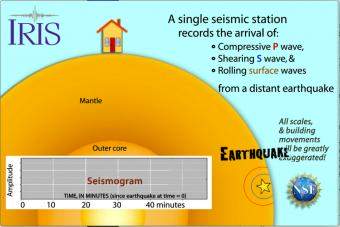1-Component Seismogram: Building responds to P, S, surface waves
How many different ways can an earthquake shake us?
An earthquake generates seismic waves that (1) penetrate the Earth as body waves (P & S) or (2) travel as surface waves (Love and Rayleigh). Each wave has a characteristic speed and style of motion. Here we exaggerate the motion by bouncing a building to show what sensitive instruments record as seismic waves arrive at the station. Animation to characterize behavior of three seismic waves. The seismogram shows the arrival times of the three generalized waves. This image just shows a single body-wave path through the Earth to avoid cluttering the image. Waves travel in all directions from an earthquake.
CLOSED CAPTIONING: A .srt file is included with the download. Use appropriate media player to utilize captioning.
Keypoints:
This highly simplified cartoon is intended to portray:
- Timing of the seismic waves (P fastest)
- The time (x-axis on the seismogram) it takes for the seismic waves to travel from an earthquake)
- Different ways the seismic waves strike a building (P = bump; S = shear; surface = rolling wobble).
- https://www.iris.edu/hq/inclass/animation/1component_seismogram_building_responds_to_p_s_surface_waves


Keine Kommentare:
Kommentar veröffentlichen